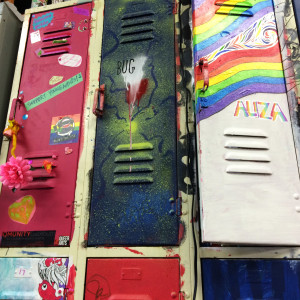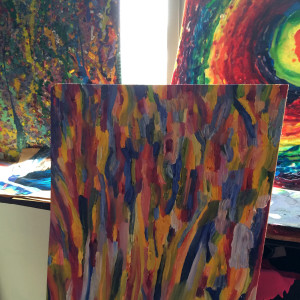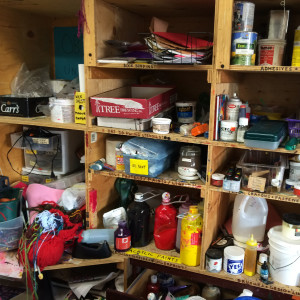I’m chatting with Aliza Bosa in the Purple Thistle Centre. The 2,500-square foot arts and activism space in East Vancouver feels remarkably spacious with only the two of us here, but signs of the centre’s visitors and their creative endeavors linger all around us—things like screen printing tools, paints, books, computers, a bike-repair station, and a large collection of sewing supplies that includes two mannequins, all jumbled together in the pleasant clutter of productivity. As a Thistle collective member, Aliza is one of the youth responsible for running the centre. There are directors to handle the grant writing, fundraising and paperwork that pay for rent and art supplies while keeping everything completely free for visitors. But the real decisions about what projects the centre focuses on and how they’re organized are up to the collective members.
That’s how it’s worked for the past fourteen years, anyway. Now the centre is in the process of closing, after the government funding that the center had relied on was discontinued and alternate sources of funding failed to materialize.
Though I hadn’t visited the Thistle in years and was never a frequent visitor, I’d attended several free workshops and events in the Thistle and had my own fond memories of the space. From the outside, the centre blends into the industrial buildings that surround the area near Clark and Venables, as though it’s just another warehouse. It’s only inside that the Thistle’s cozy studio interior reveals itself. I’d taken for granted that it would always be there for me if I needed it. The news that it would be shutting down came as a shock, and I wanted to catch up on recent happenings at the Thistle and learn what comes next.
I get the sense that it’s still a difficult topic for many of the community members who were involved; the first collective member I approached for an interview declined the request, saying that they were still processing their feelings about it. Aliza said that hearing the news for the first time at the weekly collective meeting was very hard; she’d assumed, like me, that the Thistle would be here forever.
Aliza’s first visit to the centre was around five years ago, when a friend invited her to a sewing workshop and clothing swap event. She recalls arriving to find a group of ten people sitting and mending clothes or sewing patches in a circle. Separate areas were set up for the clothing swap and snacks; though she didn’t end up doing any sewing, she did hang out and chat with a bunch of people.
Aliza describes herself as being ecstatic with her early experiences in the space. “I couldn’t even comprehend the existence of a space like the Thistle. A place that youth could access where everything is free sounds pretty unbelievable at first.”
Her excitement only increased when she realized she could join the collective and hang out in the place. “It became a kind of home,” Aliza explains. “I started getting involved, started going to the collective meetings. I was living in Fort Langley still, so it was really hard to bus out here every Monday night. I did it anyway because it was so much fun.”
For the past few years, she’s been busiest in the time leading up the annual East Side Culture Crawl in November—a four-day visual arts festival in November where artist studios, including the Thistle, are opened to the public. The festival attracts an audience of over twenty thousand, and preparing for it is always a big deal. In past years she remembers coming in to do art all night—sometimes alone, sometimes with a friend—and sitting on the couch as the sun rose, exhausted from lack of sleep but feeling great about the night’s artistic productivity.
The volume of Aliza’s painting often made it difficult to find places to let the art dry where there wasn’t a risk of someone else putting something on top of it. That’s happened quite a lot, messing up the intended look for a piece and coating the unfortunate object with glitter, sparkles, and colour. ”I always find a place to put it, but it’s hard,” she says. “You have to be really, really creative.”
Looking around us at the clutter, it’s easy to see the difficulty.
“Hang it from the ceiling?” I suggest, glancing at the exposed rafters.
“You could,” Aliza says; clearly, she’s already thought of this. “But then things would drip.”
As great as the Thistle is as a place to make art in, I sense it’s the community it creates that really makes it unique. Aliza remembers laughing with friends at the collective meetings, enjoying the food at various potlucks and parties held over the years, and attending the monthly cabarets featuring performances by community members that were organized at one point. “I have so many good memories of watching the performances there,” she says.
Perhaps part of the reason for the success of the Thistle’s community was the agency given to the youth there, the fact that everyone was in it together and everyone had an equal say—because even though everyone was working on their own projects, everyone was working together, too. Aliza is quick to emphasize this agency in helping people realize their dreams. At the weekly collective meetings, which ran on a consensus model, members would talk about the ideas and projects they were passionate about—what they wanted to do as collective members—and everyone would do their best to bring those ideas to life. If someone wanted to host a workshop or event, the collective helped make that happen however they could: providing the space, promoting it, buying the necessary supplies with collective money.
That’s what Aliza did with the free All Night Tie Dye workshop she put on last year. She tells me she’d been interested in tie-dye since she got the chance to try it at a summer camp in 2011, and she decided she wanted to do it again. So she did. “Those events were really cool, because I got to facilitate them, and I got to do it all on my own,” she explains. “I went and bought the supplies with support from the collective, and then I invited a ton of people, made the poster.”
“So you actually did it all night?” I ask, wanting to be sure I understood.
“Yeah, actually.”
Aliza explains that she’d been thinking of how cool it was to have a space that’s accessible any time—something that made the Thistle unique. She wanted to take advantage of that, so she decided to hold it literally all night—from 6pm to 6am. “I was super excited and nervous,” Aliza says, describing her feelings leading up to the workshop. “I had no idea how many people would show up.”
In the end there was a turnout of over thirty people. Aliza describes a crowded, festive atmosphere. Young kids ran around with dyed hands, since one participant brought along their siblings and cousins, and many guests brought snacks to share while making art. Some brought pajamas or pillows.
“Then it started snowing,” Aliza remembers with a smile. She and the rest of the participants stayed up doing art and tie-dye all night, pushing away the sleep. By six o’clock it was snowing outside, which made leaving difficult for those who had to travel. Many of the guests were happy about Canada winning a medal in the 2014 Winter Olympics; Aliza just wanted to go home and sleep. “But it was so much fun,” she adds.
Fun enough, apparently, for her to host two additional Tie Dye workshops in the space later that year.
It’s hard to estimate the number of young artists who have used the space for their own projects since it opened its doors fourteen years ago, but Aliza estimates the number must be in the hundreds. She’s always surprised by how many acquaintances have been involved at one point or another, even if temporarily, and the presence of past artists lingers even after they move on, in art left behind or in the hundreds of messages and doodles scrawled on the walls. On one occasion, Aliza stumbled onto a friend’s four-year-old art piece with their name on the back, a bit of the past stretching phantomlike into the present. One line scrawled on the wall in sharpie reads, simply, “I left my mark.”
Aliza isn’t sure what’s next for her art without the physical location. “I would really love to have a space to create art,” she says. “That would mean the world to me. But I guess I’m just going to have to use what I’ve got.” Finding housing in Vancouver that’s suitable for messy art making can be a real challenge, but she already has ideas about getting around that, like making a table and painting outside when it’s sunny.
Despite losing the studio space, though, Aliza seems uncomfortable with giving this story a tragic narrative. Instead, she talks about the collective’s decision to focus on the friendships, community, and projects that will continue to grow beyond the physical space. Plus, other cool things are continuing to happen in the city: Aliza points to the Surrey Youth Space, a similar project being organized by several people involved with the Thistle, as one exciting example. And the Windsor House School is moving into the Thistle’s old location, meaning that it will still be used for youth art-related projects, even if it isn’t the same.
“I think it’s really exciting to have been involved with such an amazing project, and I’m really grateful,” Aliza says. “I’ve made so many friends. I built connections. I still have those connections. That’s how I build my own community.”
Aliza begins to work on a multimedia art piece that uses dyes after our conversation comes to an end, using the Thistle’s resources to the very end. It’s a beautifully blended rainbow canvas, and she’s in the process of pouring globs of glue onto the brilliant colours; Aliza assures me that the bright white of it will dry clear, adding texture to the piece. I have a hard time imagining it, but if the completed pieces of hers leaning against the walls are any indication, she knows what she’s doing.
As she works, I walk around for the last look at the space and to say my own goodbyes. I linger over the screen-printing supplies that I’d once used in a workshop I’d attended, the sewing machines and piles of cloth that I’d never used but would have liked to. I think about the freeing, participant-focused approach that made all this possible. It feels empty with just the two of us here, but I’m reminded that it will soon be emptier still, and I can only hope that Aliza is right about the spirit of the Thistle outliving its physical presence.








